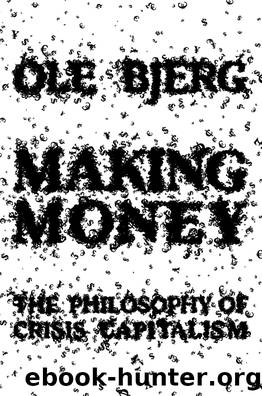Making Money by Ole Bjerg

Author:Ole Bjerg [Bjerg, Ole]
Language: eng
Format: epub
ISBN: 978-1-78168-267-8
Publisher: Verso Books
Published: 2014-04-22T00:00:00+00:00
DIRTY MONEY
Money is such a routine part of everyday living that its existence and acceptance ordinarily are taken for granted. A user may sense that money must come into being either automatically as a result of economic activity or as an outgrowth of some government operation. But just how this happens all too often remains a mysteryâ28
This quote from a text on the basic functioning of modern money points to a seeming paradox of money. Money is immediately accepted and used by almost every member of our society, while at the same time few people are able to account for the way it is brought into the world. A first reading of this paradox may suggest that money works despite the lack of understanding among the vast majority of its users. While this reading is probably true on a immediate descriptive level, insofar as money does indeed work, there is perhaps a deeper analytic truth hidden in the paradox.
Having developed the theoretical concepts of commodity money, fiat money and credit money, it might be tempting to write a simplified history of modern money as follows: In Medieval Europe, the dominant form of money was commodity money insofar as most circulating means of exchange were coins of precious metal. The value as well as the general acceptance of these coins in exchange for commodities was sustained by their intrinsic value. With the evolution of central banks and the issuance of national currencies in the form of paper bank notes, commodity money was gradually replaced by fiat money. A key event in this development was the fusion of government power with private banking when, with the Bank Charter of 1844, the Bank of England was granted monopoly for the issuance of bank notes in England. Initially, this bank money was backed by a gold standard and hence convertible to precious metal. However, the reserve requirements of the Bank of England as well as subsequent central banks were gradually loosened, and in times of crisis even momentarily suspended. The history might conclude with the collapse of the Bretton Woods system in 1971, when the link between state money and gold was definitively severed as Nixon closed the so-called âgold-windowâ. On the one hand, this event signifies the emergence of fiat money in pure form, freed of any ties to an underlying commodity value. On the other hand, the Bretton Woods collapse seems to have initiated an explosive growth in the volume of global financial markets. Insofar as this growth is fuelled by an equivalent growth in the issuance of private credit money, our contemporary economy seems to be subject to the laws of credit rather than fiat money.
Besides being a crude oversimplification of historical events, such an account is philosophically incorrect. In this chapter, we have seen how none of the three theories of money provides a coherent and comprehensive account of the constitution of money. Rather, each seems to capture no more than a few essential dimensions of the phenomenon of money. At the same time, the theories seem to be necessarily intertwined.
Download
This site does not store any files on its server. We only index and link to content provided by other sites. Please contact the content providers to delete copyright contents if any and email us, we'll remove relevant links or contents immediately.
Rich Dad Poor Dad by Robert T. Kiyosaki(6185)
Pioneering Portfolio Management by David F. Swensen(6083)
How To Win Friends and Influence People by Dale Carnegie(4340)
The Money Culture by Michael Lewis(3851)
The Dhandho Investor by Mohnish Pabrai(3564)
The Wisdom of Finance by Mihir Desai(3529)
Liar's Poker by Michael Lewis(3228)
The Intelligent Investor by Benjamin Graham Jason Zweig(2936)
The ONE Thing by Gary Keller(2922)
Mastering Bitcoin: Programming the Open Blockchain by Andreas M. Antonopoulos(2895)
Fooled by Randomness: The Hidden Role of Chance in Life and in the Markets by Nassim Nicholas Taleb(2866)
Rich Dad Poor Dad: What The Rich Teach Their Kids About Money - That The Poor And Middle Class Do Not! by Robert T. Kiyosaki(2836)
How to Win Friends and Influence People by Dale Carnegie(2799)
Investing For Dummies by Eric Tyson(2798)
How to Day Trade for a Living: Tools, Tactics, Money Management, Discipline and Trading Psychology by Andrew Aziz(2787)
Market Wizards by Jack D. Schwager(2545)
Zero Hour by Harry S. Dent Jr. & Andrew Pancholi(2536)
How to Pay Zero Taxes, 2018 by Jeff A. Schnepper(2503)
Rich Dad's Guide to Investing by Robert T. Kiyosaki(2412)
